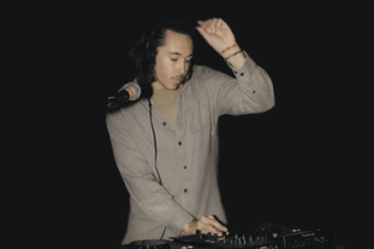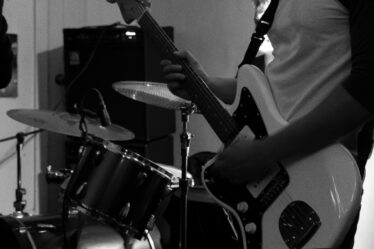By Allen Wang
As the sound engineer at Rodrigue’s Coffee House, the main responsibilities I have are to set up all the sound equipment that’s required for a live show and then mix the band during their performance. Although this process is pretty dynamic and volatile from the variety of bands that come to play, it can be explained in several steps.
Before any setup for a Rodrigue’s concert occurs, we communicate with the bands that are performing to confirm what equipment they need, among other technical details for the performance. This can be communicated through a tech sheet, which can also be referred to as a backline sheet. This document explains what equipment a venue owns, so that bands know what they should and shouldn’t bring. I also ask bands for an input list and stage plot if they have that information available to get a better understanding of their normal setup.
During the day of the show, setup begins several hours before the band goes on. First, the sound team and I move the cafe furniture outside of the building. Rodrigue’s normally functions as a student-run coffee shop, so we have to rearrange the layout of the room to make space for an audience. After the room is arranged, we set up the stage by building together the main PA speakers and stage monitors. After the main parts of the sound system are put into place, we set up the “front of house” (FOH) area, which is usually located behind the cafe counter on the side opposite of the stage area. This is where I operate the sound console and where I spend most of my time during a show. Once all of the equipment at FOH is dialed in to a default setup, I do a quick test of the sound system by playing a few songs that I know pretty well. Listening to these reference tracks through the sound system allows me to quickly check if all the speakers are working properly or if anything sounds out of place.
Following this first phase of the setup process, we proceed by setting up the backline equipment. This includes the drum set, bass amplifiers, guitar amplifiers, and other equipment that is requested by the band.
Rods is fortunate to have a good backline inventory for a venue of its size, and this allows for artists to travel to us with less gear. After the backline has been set up, I mic all the inputs that I need for the show. I do this based on an input list that I make before the show, detailing the inputs I need, its patching, the type of microphone, and the type of microphone stand. The normal set of inputs I use include kick drum, snare drum, bass, guitar, and vocal mics. Occasionally, bands will bring in keyboards, woodwinds, brass instruments, and other less-ubiquitous instruments like the theremin. Microphones are assigned based on the sound characteristics of the instrument. For example, the microphone used for the kick drum is designed differently than a microphone for a guitar or vocals. I normally use 10 to 12 nputs per show, and I tend to mic everything for a full-sounding live mix. After the mics and their stands have been placed, the band can load in their equipment and begin to soundcheck.
The process of soundcheck is designed to dial in all of the sound settings for each microphone or input. There is a fine line between taking your time to dial in these settings and perfecting the sound of each input. The time allocated for soundcheck is meant to dial in a basic mix for the show and should be done in an efficient and methodical manner. I tend to start the check with vocal mics, which are arguably the most important part of any concert. Then I check the rest of the instruments and set up the monitor mixes for the performers. I also ask the bands to play parts of different songs to check that the settings I have chosen to use match their style of music and performance.
Once all of the bands are soundchecked (usually done in the reverse order of performance order), there is some downtime before the performance. This time can be used to tie up any other loose ends before the show, or to just relax. When the show begins, I mix the band and monitor the sound console throughout the show. I also add additional effects and processing over the course of the show to enhance the band’s sound. My two signs of a good sounding mix for myself is if the vocal lies on top of the entire mix and if all of the instruments are intelligible and clear. For example, I like having a deep sounding bass guitar and a moderately compressed sounding guitar.
The process of sound engineering for a show is meticulous and requires attention to detail, but it results in a great musical experience for both the audience and venue staff. I think my team and I enjoy our jobs because of all of the opportunities we have to interact with bands and musicians from different places and genres of music. We also have a great appreciation for music and how a performance depicts the character of bands and their music.



